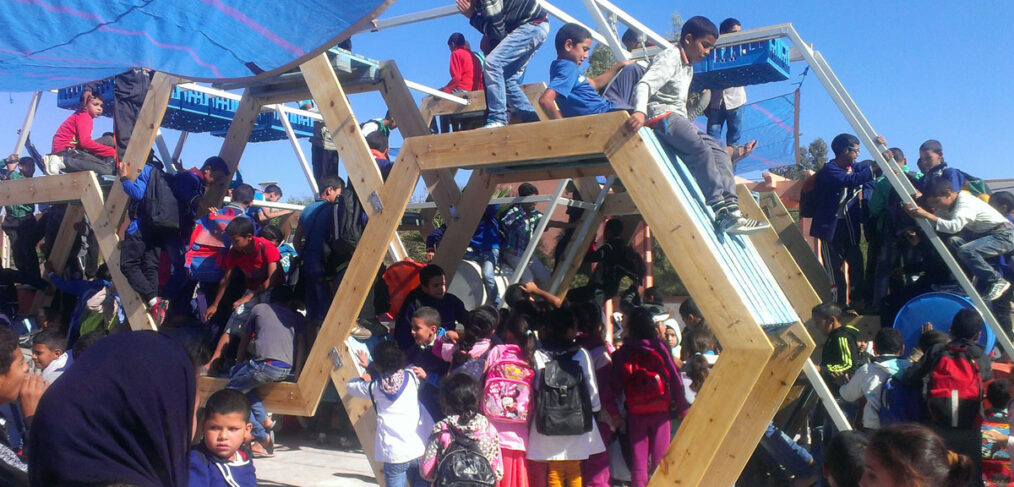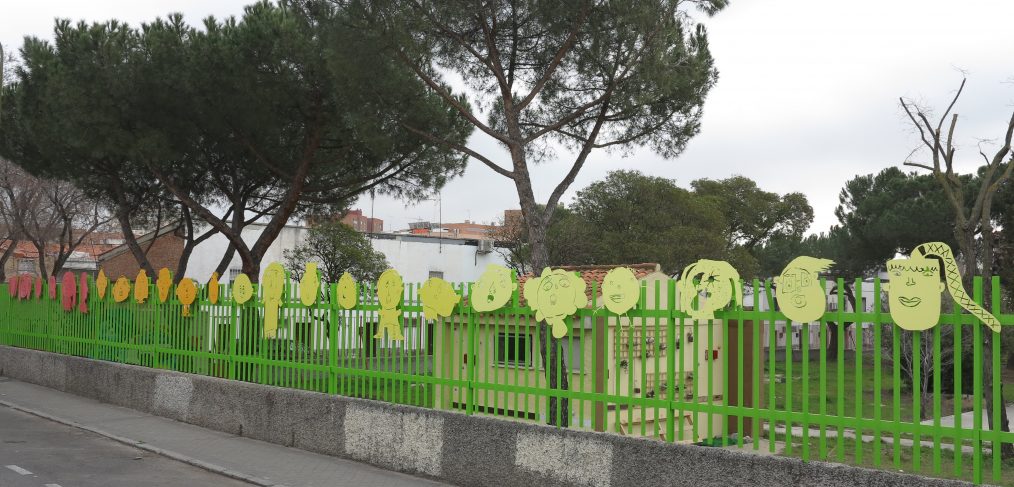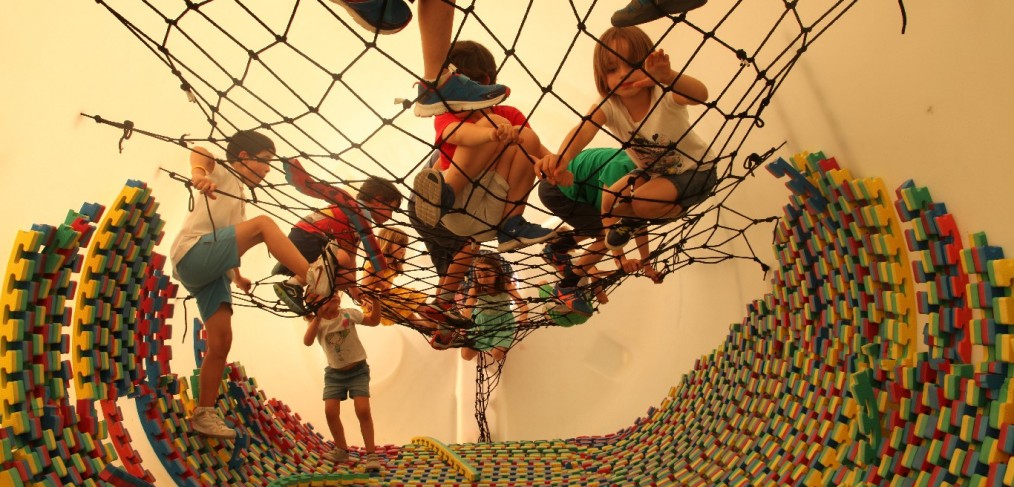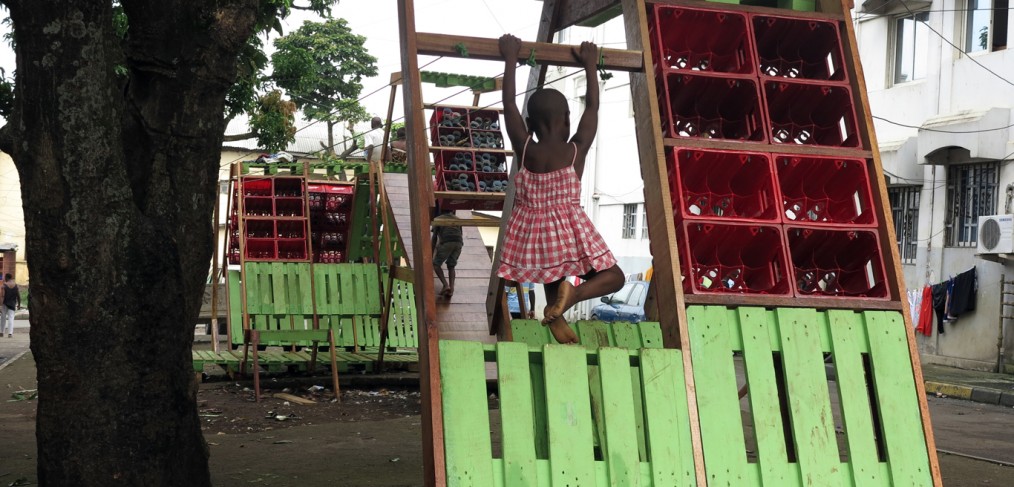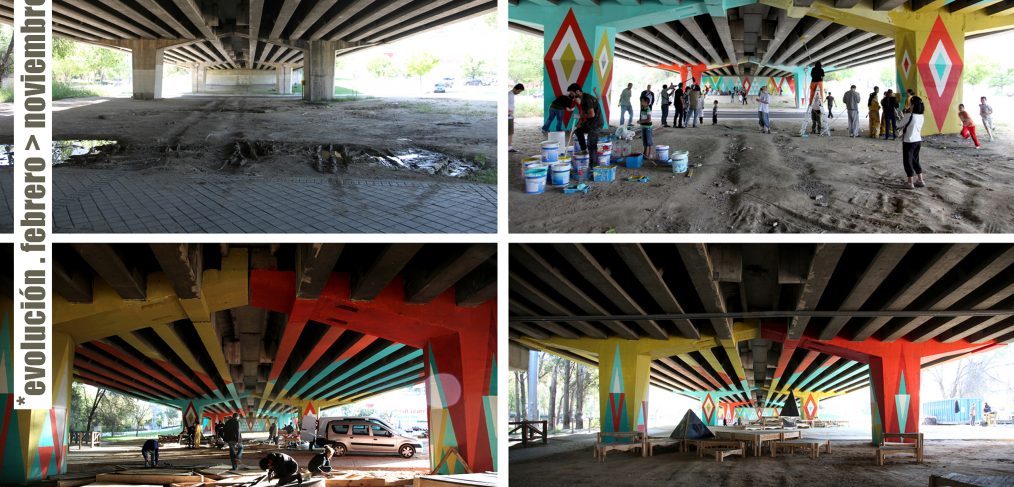Context
The school and kindergarten Manuel Núñez de Arenas is a public school in the neighborhood of Pozo de el Tío Raimundo, Madrid.
Next to the school is the local football field, which use and opening hours are restricted.
The best way to access the football field is to jump the school fence, which deteriorates the fence and damages the school equipment.
Due to what is called the broken window theory, the damage that keeps on happening on the fence, in the courtyard and in the school´s equipment, changes the dynamic, reaching an strange situation that makes some neighbors to think that this area of the school is abandonded and run-down.
Facing this situation, the board and the parent´s comitee wondered about the best way to solve this problem.
- To strength the fence?
- To mediate with the youngsters?
On the way, a group of neighbors started to work to make the space of the school more dinamic after the school´s timetable, through a project of cultural management that was also a means of self-employement and a way to mitigate the situation and provide an array of activities to the youngster of the community, which was long necessary and demanded.
By the end of 2015, with the help of Madrid City Council, opens the possibilty of carrying out an intervention that tackles this problem from an spatial intervention.
Proyect
Is there any fence that can´t be jumped?, we wondered during our first meetings carried out with the school community, as we studied pictures of fences built along borders all over the world.
We were not for it, and anyway to build a border that isolates a place doesn´t solve the problem, which in this case is the lack of spaces and activites for the youth of El Pozo.
If it´s not possible to avoid someone jumping over a fence, maybe we can turn the act of crossing the limit to change the attitude of the one who does it.
With this idea in mind we proposed the school to invest in the fence through an intervention on it.
We suggested the students of Manuel Núñez to do portraits of their classmates. Boys and girls between 4 y 12 years old.
It was very interesting to obsere the evolution in the hability of a perso to represent another human being and the perception that we have of a body and a face. Thus, we ended up with a gallery of more than 100 portraits: heads that grew limbs, faces in which the hairstyles and ornaments stand out, disproporcionate figures, frontal and side images…
The budget available only allowed to select 24 portraits that could represent the variety of the school regarding gender, age, and drawing style.
Those 24 portraits were transferred to a metal plank and painted by the students and Basurama team, together with the strech of the fence selected to do the intervention, that went from red to green.
Those protraits are looking towards the neighborhood and tell stories about a complex reality that needs to be worked on the long run, in and out of the limits of the school. We want to think that the youngster are looking for a little time of leisure in the courtyard and the football field, now they are able to understand better the value that has the space that are accesing.
When we take off our feet from the floor, extraordinary things happen. When we get out from this ground we are used to stay, we also get out from our confort space and we notice thing we usually don´t notice. We open the dors and windows of learning.
This is the aim of ‘Gatos’, an installation criated by brazilian office of Basurama with discarded metal oil barrels which transforms the courtyard of Rio de Janeiro´s Casa Daros into a playground for children under 99 years old.
In this square, children and adults can interact with the materials and the spaces, which show the creative possibilities of ‘waste’. To build this installation, were used more than 200 discarded oil barrels and an outdoor from a previous artwork by argentinian artist Fabian Marcaccio. The spaces can be freely interpretated and manipulated, entered, climbed, layed and so on.
Second collaboration stage with Escuela Ideo. “Improving the orchard of Escuela Ideo”. March 2016.
Click here for more pictures of the project.
Click here to see the first stage.
As part of Basurama line of work “Autocoles”, that tackles transformation proccesses in school´s yards. -and the informal education that comes with it-, several construction workshops about setting up the orchard of the school took place. Reutilized wood supplied by the school was used.
We designed a modular, vertical garden, with pieces from benches, shelves and cachepots. Primary school students, using many woodwork tools. We also used the orchard´s fence as a “canvas”, to create and generate designs of the vegetables to be planted.
Finally we built a group bench for the yard, using old palets and foam spare from classes
Click in here to see more pictures of the Project..
Collaborative educational project between Basurama and Escuela Ideo. Radically change the school yard as an educational strategy.
¿What could be done with a giant pipe and a 25.000l deposit in the yard of an school?
Escuela Ideo is an educative center provisionally located in an office builiding #ImaginarPatio #ConstruirPatio, arises from the neccesity of reforming a small-sized parking, into a playground space that covers the needs of pupils of different ages.
According to the ethos of the center, and the working method of Basurama (Autocoles y Autoparques), . Together with middle and high school students of the year 2014-2015 we are begining a pedagogical process of spacial transformation of the playground´s parking. This project also provides a chance for live learning, practical and interdisciplinary.
To achieve it we organize ourselves in comittes and started to develop several steps of brainstorming, design and collective construction. We work with very specific reutilized materials (supply pie, 25.000 L deposit, scenography stairs…) that we recovered from Matadero Madrid and with materials frm the school (tatami rests)).
The Comittes and steps:
- Design Comitte
- Logistics Comitte
- Tools and materials Comitte
- Paint Comitte
Changes made:
- Anamorphisims: “All you need is patio” y “Cambia tu perspectiva”(Change your perspective)
- Paint the basketball courts.
- Swings: With a tyre and a rope.
- Slide: Made with a reutilized and a ladder from a theather.
- Spatial classroom: It´s a reutilized 2500 L deposit.
More photos of the project
Pictures made by the orphanage’s children
Contex
In the gubernamental orphanage of Kibebe Tsehay, in Sidist Kilo, live children from 0 to 8 years old. There, these children study, sleep, eat, tidy up and play together.
The place has a large outdoor space with hardly any trees and wherein at some point there was some swings, practically unusable nowadays. Piled in a corner of the institution there are old cribs and beds, some parts of rusty swings and numerous shoes and clothes that no longer belong to anybody.
The metaphor of the Lost Children from the tale of James Matthew Barrie and the intention of creating a space for a minimal privacy that could enable the yard to perform recreational activities protected from the equatorial sun inspired this project.
Project
The project was completed in a record time of ten days including all stages, production, design and execution, thanks to the collaboration of a group of over 30 volunteers consisting in students of the Cervantes Institute, the University of Addis Ababa, Spanish aid workers and people who came through the call of a local radio.
After an exhaustive search of possible local resources to use in the project, it was decided to use some simple wooden pallets on which it was almost possible to recognize the tree branches with which they were made, scrap metal of the preexisting swings, and of beds and cribs that were stored in the space.
All these elements were implemented in a metal frame built with metal tube, a decision that guaranteed a minimum durability of the intervention in a place that rarely have the possibility to improve its space.
The intervention was completed with the installation of a deck built with advertising canvas donated by a local company, designed to extend or not according to the needs of each moment.
Some personal items left by former residents of the orphanage were painted in red and placed in the space in their memory.
The use of these low cost materials and the synchronization of all available resources, allowed to finish the intervention in the time and budget available.
The project culminated with the official opening of the intervention and a lecture at the School of Architecture in Addis Ababa.
More pictures
Context
Mafalala is one of the most populars neighborhoods of Maputo, Moçambique. Celebrities as the footbal player Eusebio (a.k.a. the Black Panter), Samora Machel (first president of the independent Moçambique) or the poes Noémia de Sousa and José Craveirinha grew up in this neighborhood.
During the foundation of Maputo (eighteenth century) native Mozambicans were forced to live beyond the city planned by the Portuguese settlers, giving to Mafalala an other outers neighborhood that very recognizable and informal aspect of one floor dwellings made from wood and iron sheet.
Nowadays the Iverca Association tries to spreed the history and values of Mafalala by promoting tourism and cultural activities, mainly the Mafalala Festival.
Project
Invited by the Spanish Embassy in Mozambique, Basurama participated in the Mafalala Festival of 2013, carrying out an open workshop for volunteers from diverse associations with the objective of building a playground in one of the schools of Mafalala, the Escola Unidade 23.
The school lacked any type of furniture that would allow to enjoy an outer space full of potentials, mainly a big tree in its courtyard.
Together with the participants, Basurama designed and built small elements made by cardtyres recovered around the neighborhood that were used to activate the smallets spaces. The perimetral wall was converted in a vertical garden made with plastic bottles and plants harvested in the streets close to the school. Finally, the courtyard was transformed in a big playground made with pallets donated by a local enterprise.
We think that this process of training of a community through the co-designing and co-building with local resources is a way is a way to generate autonomous processes and lasting transformation in time.
Interview made the day of the project’s openning. Video made by Maria Rusca.
Context
A brief passage in the town of Malabo (capital of Guinea Equatorial) is enough to realize that its public is almost non-existent. Beyond the numerous bars of the city and their terraces token over the side walk, the street is a space of transition. Only a few places are used as public space even though they’ve bot been conceived such as.
Therefore and differently from other African towns, formal and informal usages of the public space are rare. As much the usages linked to private economic exploitation than the ones linked to rest, discussion, games and recreation.
It can’t be said about Malabo that exist there a culture of utilisation of public space (neither generically or as a characteristic of the city). This could be read and used as a generator of an intervention project in a vacant space of the town.
Project
On the occasion of the IIIrd edition of the Eco Carnaval, an event organized by the ICEF (Institut Culturel d’Expression Francaise, Cultural Institute of French Expression), the CCE (Cultural Center of Spain in Malabo) invited us to participate at the event. They proposed us to perform an intervention in the Chinese Neighborhood (Barrio Chino), a central part of the city near by the central market.
The first site visit wasn’t really encouraging: diverse cars parked across the central reservation of the place of intervention (some of them clearly abandoned), garbage covering the floor, lack of public lightning (lamp posts removed by invasive cars) and washing lines stretched between the trees ans the last lamp posts. This is compounded by uneven terrain and the impossibility for political reasons and absence of authorization to build in situ.
However some characteristics of the site appeared to be susceptible to generate an intervention which would give qualities of usage to the place. Those clothes we have seen hanging across the central reservation and the long of the walls actually indicated us that existed there somehow an utilisation of the space by the community. This was interesting to promote. Furthermore at the centre of the central reservation lies a big mango tree, providing shade to a large part of the site. The mango characterises the space and invited us to articulate our project around it.
Considering this informations we decided to carry out a project that would promote the uses identified locally and develop them around a new function: a children’s playground.
About the materials available, the CCE of Malabo had conducted a preliminary quest, collecting transport pallets of different sizes and plastic crates from a well known drinks brand. We had enough material, the problem was then assembling objects of such a variety of sizes.
The main problem we were faced to, in addition of the patchwork of materials, was being unable to work on the site except during the specific date of the Eco Carnaval. Confronted to this restrictions our strategy was generating quickly a system which could match itself to the materials available through forming an assorted ensemble. This way focusing our efforts on the durability of the project and an easy-adaptation to the uneven terrain.
We decided then to develop the project around regular hexagon (form already experimented during pasts Autoparque projects). Transforming slightly this figure generated the system adapting itself to materials. Thereby we had been able to produce independent modules (easier to transport from the construction site until the place of intervention) capable both to combined with each other and adapt the ground.
During the days following the design we built and transported the modules composing the project, using the pallets as resisting element where could children climb and adults sit, simultaneously providing shade and supports for small suspended garden in the plastic crates.
The second part of the invitation was the participation to the Eco Carnaval parade on the 15th of november 2014. We proposed to make a party from the transport of the ultimate module. Gathering all the families of CCE workers and spontaneously other persons (mostly children), we paraded carying our structure through Malabo streets. Finally we made out of the final montage a public event.
Autobarrios was launched in January 2012 in the Madrid suburb of San Cristóbal de los Ángeles. The goal of this project was not to create a new responsibility for the neighborhood but to join in to existing processes, becoming an excuse to consolidate them. After that, various neighborhood associations joined forces to create a platform that is now managing the Self-made-neighborhoods project.
This platform defined Autobarrios SanCristobal as a collective process of revival of an abandoned space, reinventing its function and use by building evocative urban space by and for neighborhood youth and other neighbours.
Since then, the project has followed a natural process based on the consolidation of trust between the different actors. The project has also focused on connecting local resources to encourage, define and make possible the main initiatives. Nowadays this process continues developing and enabling the managment and start-up of the urban space, whose construction was completed in May 2014, looking after the cultural and social activities programmed that allow the neighborhood to evolve and grow.
All the images of the project in the facebook of Autobarrios SanCristobal.
VIDEOS
THE PROCESS
Strategies of community urban development initiative to dignify and transform an abandoned place in a useful space that respond to the needs of the residents
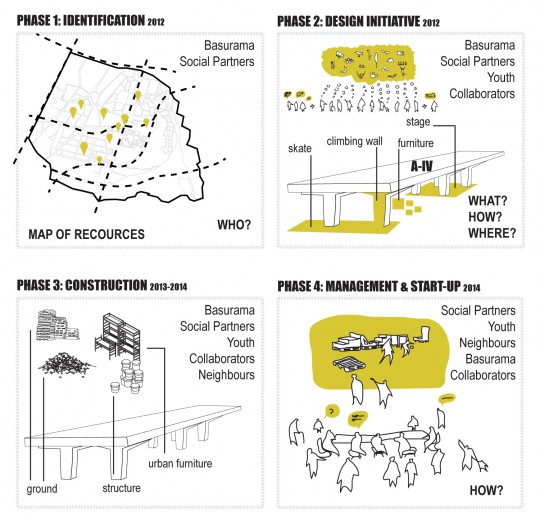
PHASE III (2013-2014) REVITALIZATION Y CONSTRUCTION
Autobarrios SanCristobal is an organic project that evolve in real time. In the construction phase, the available ressources delimit the design of the urban furniture, the associated uses and execution times. That way, interventions were guided by the available possibilities and were planned and executed independently.
The proposals drawn by the participants define a living space made of active uses, not defined only by the design of furniture but also by the following social and cultural production.
> Phase 1 = Refurbishment
+ Painting > revitalization of 1945 m2 surface: #colorfulsancris Part I (February 2013) y Part II (May 2013) developed with Boa Mistura. In collaboration with Productos Diez and Torremovil – Layher.
+ Floors > cleaning and adjustment of 2597 m2: #arreglandolapachamama (September 2013) in collaboration with Madrid City Hall.
> Phase 2 = Construction
+ Multiuse urban structure > revitalization of the northern area (1131 m2): #bricosancris Part II (November 2013) developed with Collectif Etc. In collaboration with Institut Français de Madrid, Matadero Madrid, Acciona and Renault.
+ Multiuse urban structure > revitalization of the southern area (726 m2): #bricosancris Part III (April 2014). In collaboration with Matadero Madrid, Acciona and Renault.
+ Floors > construction of a sheltered path of rain in the northwestern area: #bricosancris Part IV (May 2014). In collaboration with Bibliobuses Madrid, Acciona y Renault.
> Phase 3 = Finishing Touch
+ Electrical Connection / Wifi Connection
+ Equipment (signage, security, cleaning)
PHASE IV (2014) MANAGMENT & START-UP
Public space is continuously constructed through social and cultural production that maintains a place alive and constantly evolving: in this context is inscribed the training of young neighborhood of San Cristobal in the sustainable management of local activation and space recovered. A technical and cultural training that allowed to consolidate processes that are already underway in the neighborhood and activate those that are not, making young people cultural managers in their own space.
The Cultural Management Course will work with young people, since June, cultural, technical and administrative autonomy to facilitate cultural experiences under the recovered bridge.
DEVELOPED WITH
Young people are the protagonists of this project. They are the designers and builders of a public space that would be use by the whole district.
> Network of social partners and neighborhood of San Cristóbal de los Ángeles: Local associations and groups that are part of the Platform for Autobarrios initiatives that ensures the appropriate way to guide and monitor the entire process for integrating the project into the social tissue of the neighborhood.
Casa San Cristóbal-Fundación Montemadrid: social center open to the neighborhood, has a strong social and cultural programme. Collaborates and partially finances the project Autobarrios SanCristobal with La Casa Encendida of Fundación Especial CajaMadrid.
Educación Cultura y Solidaridad: Nonprofit Association. Working for social integration in the neighborhood, offering socio-cultural resources to children, youth, adults and families in the neighborhood.
Asociación de Vecinos La Unidad de San Cristóbal: created in 1978 and declared “public utility” in 1985, works on participation, promotion and management of various plans for the improvement of the neighborhood and the defense of the interests of the residents
> Partners: Professionals who collaborate to provide advice and a quality finished to the technic part of the project.
Boa Mistura: Collective of artists born in Madrid mainly involved in public space through urban art, having carried out projects in South Africa, Norway, Berlin or Brasil.
Collectif Etc: Group of French architects who build public space integrating local people in the creative process.
lacasinegra / Vermut / Nervio Films&Foto: Art collectives focused on the creation, management, research, reflection and cultural production through film making and audio-visual devices.
Obsoletos: research project, creation and distribution of creative transformation systems technological waste.
> Network of business partners from the industrial area of Villaverde: Local companies – major players in the development of the District of Villaverde – who collaborate through their implication as professionals, giving tools or providing materials or unused stock that can be reused for shaping the space.
ProductosDIEZ S.A. Enamels and paints factory.

Torremovil de Layher Scaffolding systems company.
![]()



> Other Partners:
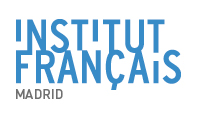
![]()
FUNDED BY:
Casa San Cristóbal and La Casa Encendida – Fundación Montemadrid

More info:
THE PROJECT
Autobarrios – Self-made-neighborhoods- helps to create an iniciative for urban community development: it uses the collective construction of an urban imaginaire as a tool for empowering the community as a creative body.
Throughout creative practices, the enhancement of local resources and networking, strategies to practice more neighbours are created.
THE FRAMEWORK
The project reflects on the scale of the neighborhood and the current state of its essence, which, we understand, is based on relationships, daily life and identity and the common spaces that contain them.
Autobarrios is a contextual tool designed to grow in different neighborhoods taking into account their own particularities. It relies on outreach work and creative practices stimulates our collective imagination, our autonomy and our ability to deal with our daily networks and the surrounding environment ¡Reinvent your neighborhood!
THE TOOLS
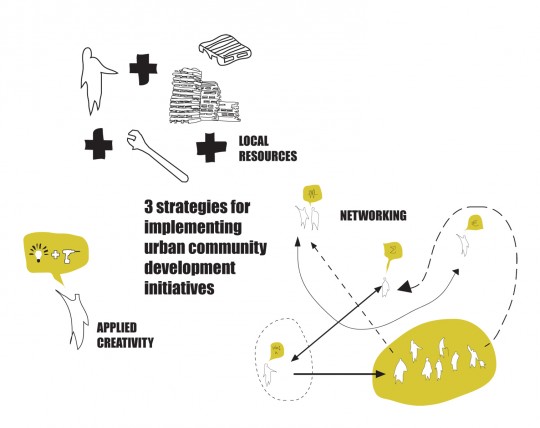
> Applied Creativity
The project believes in applied creativity as a great tool for community development. The goal is not only to build something useful but activate the creative potential and catapult the imagination of the participants as citizens, builders and users.
> Revaluation of local resources
The project helps to create a network of people and resources that shape this initiative working together with their existing projects, becoming an excuse for strengthening them.
> Networking
Autobarrios is an example of city building shared between different professional areas and citizens. In this sense, one of the key project is coordinating a networking between all possible actors that can, from different areas, enrich and enable the smooth running of the project.
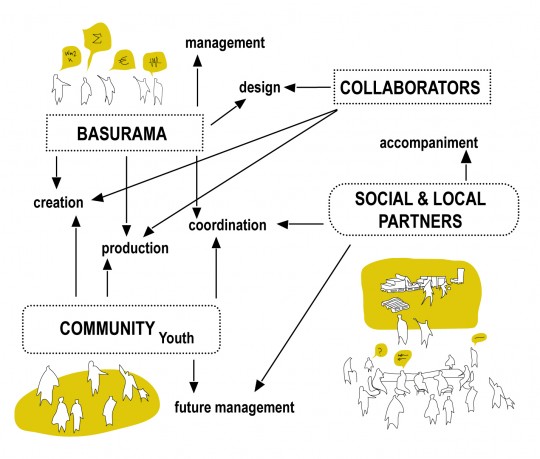
REALIZED PROJECTS
Autobarrios SanCristobal in process from January 2012.
